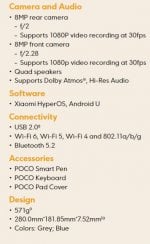I've had the opportunity to attend the launch and represent Jesus. During the event, I've had access to the new devices, tried their standout features and also interviewed Angus Ng, head of product marketing at POCO Global. I asked some questions about gaming phone designs, especially around physical controls, as well as the barriers to have decent front-facing cameras on Android tablets. Read on to learn what the representative behind one of the most prominent gaming smartphone brands has to share.
POCO F6
POCO's latest line comes in two models: the F6 and the F6 Pro. These vary in specs and aesthetics, with the F6 model being available in Black, Green and Titanium and the F6 Pro being available in Black and White. They also differ in pricing and storage. Storage variants of the POCO F6 are 8+256GB and 12+512GB; while the F6 Pro comes in 12+256GB, 12GB+256GB and 12GB+1TB. The latter variant is a rather unique option for smartphones, especially at that price range.
Specs of the phones can be found below:
While the specs are not those of flagships such as the Xiaomi 14 Ultra, within this price range, they are quite aggressive and are definitely daily-driver material with decent gaming capabilities. Regarding the build quality, both the F6 and F6 Pro look and feel like high-end devices. They feel good in the hands, especially with the curved edges, and deliver crisp visuals with their AMOLED displays.
Traditionally, POCO didn't have much of a focus on their phone's camera but they are changing this approach with the F6 series. This includes some handy and impressive features such as the Ultra Night Algorithm of the F6 Pro which significantly improves the quality of pictures in low-lighting conditions. POCO is also jumping on the AI hype-train with some AI features such as modifying portraits with AI-generated settings based on your prompts, expanding the background of pictures and AI search of your gallery. I found the former option to be a rather nice-to-have feature to play around with and the results were quite convincing.
Within its marketing lingo, POCO mentions "Wildboost Optimization 3.0". This improves performance on popular games such as 1.5K resolution with Genshin Impact and 120 FPS mode with PUBG Mobile.
Considering the pricing, specs and performance, the POCO F6 series is an attractive contender as a daily driver that is very capable of gaming. However, some features and specs are only locked to the pricier Pro version, such as the Ultra Night Algorithm and 1TB storage option. Having those features on the regular model would be also be welcome.
But the major missing feature in current gaming smartphones is - and I won't tire myself of saying this - physical controls. POCO was actually one of the only companies with physical controls on a smartphone, in the form of mechanical triggers. However, since the POCO F4 GT, the company has not issued any phones with such a hardware; despite targeting mobile gamers, and it is a real downer. I brought this up with Mr. Ng and you can read his response below.
A full review of the POCO F6 Pro is coming up and will include its performance with Android games and emulators. So keep an eye out for the review!
POCO Pad
POCO's first Android tablet is the affordably-priced POCO Pad which packs the following specs:
While not crammed with the latest specs, for casual and light productivity uses, it should be adequate. With its slim metal unibody design, it packs an attractive and sturdy build. Aesthetically, the POCO Pad makes a strong impression considering it is the company's first tablet.
As such devices are aimed at productivity use cases, POCO sells accessories separately to support such ends. They have a keyboard cover and a smart pen. The latter is pressure-sensitive, making it adequate for sketches as well as note-taking. However, these accessories are not included in the base package and have to be purchased separately.
In addition to work uses, the POCO Pad is also well adapted for entertainment purposes. With a 2.5K, 12.1" display boasting 120Hz refresh rate and quad-speakers with Dolby Atmos support, this tablet is well equipped for video streaming. These should also lend themselves well to gaming purposes, although I have yet to try the Pad's gaming prowess.
It was refreshing to see that POCO did not oversell the Pad with marketing buzz-words. It looks and feels like a no-frills tablet as your secondary work/entertainment device. The company might also be playing it safe as this is their first such device. This might be for the best but a verdict will be shared in the upcoming full review of the POCO Pad.
















